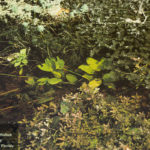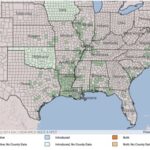Echinodorus cordifolius
Illustration courtesy of University of Florida/IFAS Center for Aquatic and Invasive Plants. Used with permission.
What is Creeping Burhead?
Physical Characteristics
Leaves:
- Leaf stalk up to 0.75+ inches long
- Blade egg-shaped
Flowers:
- White
- 0.47+ inches in diameter
Flower Stalk:
- Leafless
- Creeping
- Up to 4 feet long
- Many whorls of flowers
Fruit:
- Small
- Dry
- One-seeded
- Does not open to release seed
Stem:
- Rough texture
Where Does it Grow?
USDA, NRCS. 2018. The PLANTS Database (http://plants.usda.gov). National Plant Data Team, Greensboro, NC 27401-4901 USA.
Creeping burhead can be found in the mud and shallow water of ponds and quiet streams.
Pros and Cons of Creeping Burhead
Submerged portions of all aquatic plants provide habitats for many micro and macro invertebrates. These invertebrates in turn are used as food by fish and other wildlife species (e.g. amphibians, reptiles, ducks, etc.). After aquatic plants die, their decomposition by bacteria and fungi provides food (called”detritus”) for many aquatic invertebrates.



